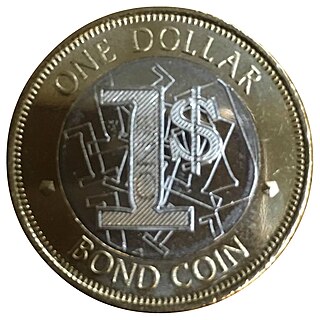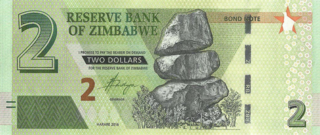Related Research Articles

The economy of Zimbabwe is a gold standard based economy. Zimbabwe has a $44 billion dollar informal economy in PPP terms which translates to 64.1% of the total economy. Agriculture and mining largely contribute to exports. The economy is estimated to be at $73 billion at the end of 2023.

A gold standard is a monetary system in which the standard economic unit of account is based on a fixed quantity of gold. The gold standard was the basis for the international monetary system from the 1870s to the early 1920s, and from the late 1920s to 1932 as well as from 1944 until 1971 when the United States unilaterally terminated convertibility of the US dollar to gold, effectively ending the Bretton Woods system. Many states nonetheless hold substantial gold reserves.

Legal tender is a form of money that courts of law are required to recognize as satisfactory payment for any monetary debt. Each jurisdiction determines what is legal tender, but essentially it is anything which when offered ("tendered") in payment of a debt extinguishes the debt. There is no obligation on the creditor to accept the tendered payment, but the act of tendering the payment in legal tender discharges the debt.
Digital gold currency is a form of electronic money based on mass units of gold. It is a kind of representative money, like a US paper gold certificate at the time that these were exchangeable for gold on demand. The typical unit of account for such currency is linked to grams or troy ounces of gold, although other units such as the gold dinar are sometimes used. DGCs are backed by gold through unallocated or allocated gold storage.

The Reserve Bank of Zimbabwe is the central bank of Zimbabwe and is headquartered in Harare.

Money is any item or verifiable record that is generally accepted as payment for goods and services and repayment of debts, such as taxes, in a particular country or socio-economic context. The primary functions which distinguish money are: medium of exchange, a unit of account, a store of value and sometimes, a standard of deferred payment.
Metallism is the economic principle that the value of money derives from the purchasing power of the commodity upon which it is based. The currency in a metallist monetary system may be made from the commodity itself or it may use tokens redeemable in that commodity. Georg Friedrich Knapp (1842–1926) coined the term "metallism" to describe monetary systems using coin minted in silver, gold or other metals.

Hyperinflation in Zimbabwe is an ongoing period of currency instability in Zimbabwe which, using Cagan's definition of hyperinflation, began in February 2007. During the height of inflation from 2008 to 2009, it was difficult to measure Zimbabwe's hyperinflation because the government of Zimbabwe stopped filing official inflation statistics. However, Zimbabwe's peak month of inflation is estimated at 79.6 billion percent month-on-month, 89.7 sextillion percent year-on-year in mid-November 2008.

The Zimbabwean dollar was the name of four official currencies of Zimbabwe from 1980 to 12 April 2009. During this time, it was subject to periods of extreme inflation, followed by a period of hyperinflation.
Circle is a peer-to-peer payments technology company that now manages stablecoin USDC, a cryptocurrency the value of which is pegged to the U.S. dollar. It was founded by Jeremy Allaire and Sean Neville in October 2013. Circle is headquartered in Boston, Massachusetts. USDC, the second largest stablecoin worldwide, is designed to hold at or near a stable price of $1. The majority of its stablecoin collateral is held in short-term U.S. government securities.
CoinDesk is a news site specializing in bitcoin and digital currencies. Founded by Shakil Khan, the firm also provides guides to bitcoin for those new to digital currencies.

The Reserve Bank of Zimbabwe began to release Zimbabwean bond coins on 18 December 2014. The coins were supported by a US$50 million facility extended to the Reserve Bank of Zimbabwe by Afreximbank. To date coins worth US$15 million have been struck out of the total $50 million available. The coins were first issued in denominations of 1, 5, 10, and 25 cents and are pegged to the corresponding values in U.S. dollars. A 50 cents bond coin was released in March 2015.
John Panonetsa Mangudya is a former governor of the Reserve Bank of Zimbabwe. He was appointed in March 2014 by the then Zimbabwean president, Robert Mugabe, and began his tenure as governor on 1 May that year. His second 5 year term ended on 28 March 2024. He succeeded Gideon Gono as the governor of Zimbabwe's central bank and became the nation's 6th substantial exchequer.
An initial coin offering (ICO) or initial currency offering is a type of funding using cryptocurrencies. It is often a form of crowdfunding, although a private ICO which does not seek public investment is also possible. In an ICO, a quantity of cryptocurrency is sold in the form of "tokens" ("coins") to speculators or investors, in exchange for legal tender or other cryptocurrencies such as Bitcoin or Ether. The tokens are promoted as future functional units of currency if or when the ICO's funding goal is met and the project successfully launches.

Zimbabwean Bonds were a form of legal tender near money released by the Reserve Bank of Zimbabwe which attempts to resolve Zimbabwe's lack of currency. Bonds and were pegged against the U.S. dollar at a 1:1 fixed exchange rate and backed by the country's reserve. Since abandoning the Zimbabwean dollar in 2009 after it went into hyperinflation the country began using a number of foreign currencies including the U.S. dollar, South African rand, British pound and Chinese yuan as a means of exchange. The inability to print these currencies led to a shortage of money with banks issuing limits on withdrawals.

Zimbabwean bond notes are a form of banknote in circulation in Zimbabwe. Released by the Reserve Bank of Zimbabwe, the notes were stated to not be a currency in itself but rather legal tender near money pegged equally against the U.S. dollar. In 2014, prior to the release of bond notes, a series of bond coins entered circulation.
A stablecoin is a type of cryptocurrency where the value of the digital asset is supposed to be pegged to a reference asset, which is either fiat money, exchange-traded commodities, or another cryptocurrency.

The Zimbabwean dollar, also known as the Zimdollar or Real Time Gross Settlement (RTGS) dollar, was the currency of Zimbabwe from February 2019 to April 2024. It was the only legally permitted currency for trade in Zimbabwe from June 2019 to March 2020, after which foreign currencies were legalised again.
The Zimbabwe Gold (ZiG) has been the official currency of Zimbabwe since 8 April 2024, backed by US$575 million worth of hard assets: foreign currencies, gold, and other precious metals. It replaced the Zimbabwean dollar, which suffered from rapid depreciation, with the official exchange rate surpassing 30,000 Zimbabwean dollars per U.S. dollar on 5 April 2024, whilst the parallel market rate reached 40,000 per U.S. dollar. Annual inflation in Zimbabwe hit 55.3% in March 2024.
John Mushayavanhu is a Zimbabwean central bank governor and former FBC Holdings Limited boss.
References
- ↑ "RBZ unveils new currency – The Herald". www.herald.co.zw. Retrieved 2024-04-08.
- ↑ "RBZ Mandates Conversion of All Zimdollar Balances to ZiG". 2024-04-05. Retrieved 2024-04-08.
- ↑ Weekly, eBusiness (2023-08-29). "Zimbabwe Gold (ZiG) not loanable – RBZ". eBusiness Weekly. Retrieved 2024-04-08.
{{cite web}}:|first=has generic name (help) - ↑ "Zimbabwe's central bank launches new digital transacting currency-Xinhua". english.news.cn. Retrieved 2024-04-09.
- ↑ "Zimbabwe plans to launch digital currency backed by gold". AP News. 2023-04-28. Retrieved 2024-04-09.
- ↑ "NATIONAL ASSEMBLY HANSARD 14 DECEMBER 2023 VOL 50 NO 21". Parliament of Zimbabwe. Retrieved 2024-04-06.
- ↑ "Gold Sold". Chronicles Zimbabwe. 2024-02-28. Retrieved 2024-04-09.